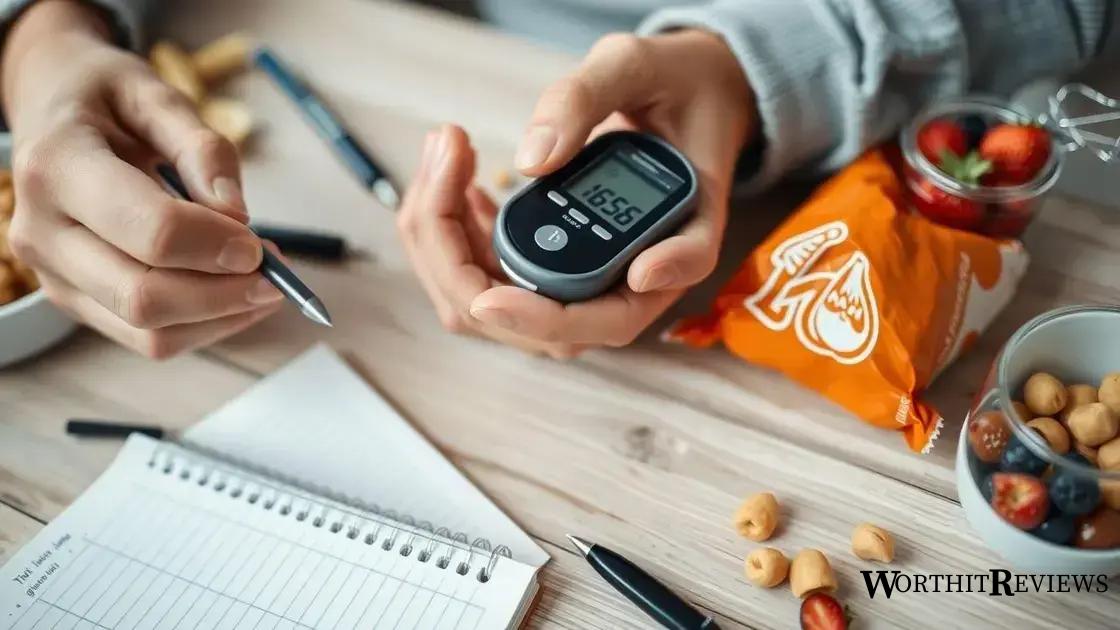Effective management of glucose readings for type 2 diabetes involves regular monitoring, proper diet, exercise, and understanding when to consult a healthcare professional to maintain healthy blood sugar levels.
Glucose readings for type 2 diabetes are vital for effective management of the condition. Have you ever wondered how these numbers affect your daily life? Let’s explore their significance together.
Understanding type 2 diabetes and glucose levels
Understanding type 2 diabetes is essential for managing your health effectively. This condition occurs when the body becomes resistant to insulin or when the pancreas fails to produce enough insulin. Glucose levels fluctuate throughout the day based on various factors including food intake, physical activity, and stress.
Maintaining balanced glucose levels is crucial for preventing complications. A typical fasting blood glucose level should be below 100 mg/dL, while levels between 100 and 125 mg/dL indicate prediabetes. Readings over 126 mg/dL suggest diabetes.
Importance of Regular Monitoring
Regularly checking your glucose levels can help you identify patterns and triggers that affect your readings. This awareness allows you to make informed decisions about food, exercise, and medication.
Recognizing Symptoms
Symptoms of high glucose levels can include increased thirst, frequent urination, fatigue, and blurred vision. If you notice these signs, it’s vital to contact your healthcare provider.
Conversely, low glucose levels, known as hypoglycemia, can cause shakiness, sweating, irritability, and confusion. Understanding both high and low glucose symptoms is key to managing type 2 diabetes effectively.
How to monitor your glucose readings effectively

Monitoring your glucose readings effectively is vital for managing type 2 diabetes. Regular checks help you understand how different foods, activities, and stress levels affect your blood sugar.
Choose the Right Tools
Select a reliable glucose meter. Many modern meters offer features like memory storage, data export, and even smartphone connectivity for tracking trends over time. Make sure you understand how to use it properly.
Establish a Routine
Consider checking your glucose levels at consistent times each day. For example, you might measure your levels before meals and a couple of hours afterward. This helps you see how food impacts your levels more clearly.
Keep a Log
Maintain a log of your readings along with notes about what you ate, your physical activities, and your stress levels. This can reveal patterns and help you make informed decisions.
Utilize Continuous Glucose Monitors (CGMs)
For more advanced monitoring, consider using a Continuous Glucose Monitor (CGM). A CGM provides real-time glucose levels and trends, which can be useful for spotting high or low instances quickly.
Stay Informed
Educate yourself about normal averages for glucose readings and what specific numbers mean for your health. Aim for fasting levels between 70-130 mg/dL before meals and below 180 mg/dL after meals.
If you notice patterns that concern you, do not hesitate to discuss them with your healthcare provider. They can offer tailored guidance and adjustments to your management plan.
What do glucose readings indicate about your health?
Glucose readings provide essential insights into your health, especially for those managing type 2 diabetes. These readings can help you assess how well your body processes sugar and reacts to food intake, exercise, and stress.
Normal Glucose Levels
A normal fasting glucose level is typically between 70-99 mg/dL. After meals, it’s generally acceptable for your levels to rise but should remain below 140 mg/dL within two hours.
Indications of High Glucose Levels
If your glucose readings frequently exceed 130 mg/dL before meals or 180 mg/dL after meals, it may indicate uncontrolled diabetes or prediabetes. Always consult with your healthcare provider to manage these levels efficiently.
Signs of Low Glucose Levels
On the other hand, readings below 70 mg/dL indicate hypoglycemia, which can lead to symptoms like shaking, dizziness, and confusion. Recognizing these symptoms early can prevent serious complications.
Tracking Patterns Over Time
By consistently monitoring your glucose levels, you can identify patterns that affect your health. For example, spikes after certain meals may guide you to make better food choices.
Consulting Healthcare Professionals
Understanding what your glucose levels indicate is crucial for effective diabetes management. Regular discussions with your healthcare team can help tailor your treatment and lifestyle to maintain optimal glucose control.
The impact of diet on glucose readings

Your diet plays a crucial role in managing glucose readings, especially for those with type 2 diabetes. What you eat directly affects your blood sugar levels, so understanding the relationship between food and glucose is essential.
Carbohydrates and Blood Sugar
Carbohydrates have the most significant impact on your glucose levels. Foods high in simple sugars, such as candy and soda, can cause rapid spikes in blood sugar. In contrast, complex carbohydrates, like whole grains and legumes, provide steady energy and release sugar more gradually.
Fiber’s Role
Including fiber-rich foods in your diet is beneficial. Fiber slows down the digestion of carbohydrates, which helps maintain stable glucose levels. Good sources of fiber include fruits, vegetables, beans, and whole grains.
Protein and Fats
Incorporating protein and healthy fats into your meals can also help manage glucose. They can slow down the absorption of carbohydrates, leading to more stable blood sugar levels. Options like nuts, seeds, fish, and avocados are excellent choices.
Meal Timing and Portion Control
Your meal timing and portion sizes matter too. Eating smaller, balanced meals throughout the day can prevent large spikes in blood sugar. Consider monitoring your portion sizes to avoid overeating.
Consultation with Nutritionists
Working with a healthcare provider or dietitian can help you create a personalized meal plan that aligns with your glucose management goals. They can provide tailored advice on foods to focus on and those to limit.
Exercise and its effects on glucose control
Exercise plays a significant role in controlling glucose levels for individuals with type 2 diabetes. Regular physical activity helps your body use insulin more effectively, which can lead to improved blood sugar control.
How Exercise Affects Blood Sugar
When you exercise, your muscles use glucose for energy, which helps lower blood sugar levels. This effect can last for hours after your workout. Engaging in both aerobic and strength training exercises is beneficial.
Types of Exercises
Aerobic exercises like walking, jogging, swimming, and cycling can effectively lower glucose levels. Aim for at least 150 minutes of moderate exercise each week. Strength training, on the other hand, helps build muscle, which can improve your body’s insulin sensitivity.
Creating an Exercise Routine
Establish a consistent exercise routine that fits your lifestyle. Start with simple activities, like walking for 10-15 minutes a day, and gradually increase the intensity and duration over time. This helps make exercise a sustainable habit.
Monitoring Blood Sugar During Exercise
Monitor your glucose levels before and after exercising, especially if you’re new to a routine. This way, you can understand how different activities affect your blood sugar. If levels drop too low, have a small snack ready to prevent hypoglycemia.
Consulting with Healthcare Professionals
Before starting any new exercise routine, it’s essential to consult with your healthcare provider. They can provide personalized recommendations based on your current health status and medication.
Managing stress to stabilize glucose levels

Managing stress is essential for stabilizing glucose levels in individuals with type 2 diabetes. Stress can cause the body to release hormones that increase blood sugar, making effective stress management crucial.
Understanding the Link Between Stress and Glucose
When you’re under stress, your body produces hormones like cortisol and adrenaline. These hormones can raise blood sugar levels by signaling the liver to release stored glucose into the bloodstream.
Techniques for Reducing Stress
There are several effective techniques to manage stress. Regular exercise, such as walking, yoga, or swimming, can help lower stress levels. Additionally, breathing exercises and meditation can promote relaxation and lower glucose spikes.
Prioritizing Sleep
Getting enough quality sleep is also vital for stress management. Lack of sleep can increase cortisol levels, leading to higher blood sugar. Aim for 7-9 hours of restful sleep each night.
Mindfulness and Relaxation Techniques
Practicing mindfulness can help you stay calm in stressful situations. Consider techniques like deep breathing, guided imagery, or progressive muscle relaxation to cope with daily stressors.
Seeking Support
Don’t hesitate to seek support from friends, family, or a mental health professional. Having a strong support system can significantly reduce feelings of stress and improve your overall well-being.
Common misconceptions about glucose monitoring
Many people have misconceptions about glucose monitoring, which can lead to ineffective management of diabetes. Understanding the facts can help improve control over blood sugar levels.
Misconception 1: Only Diabetics Need to Monitor Glucose
Some believe that glucose monitoring is only necessary for those diagnosed with diabetes. However, individuals with prediabetes should also monitor their levels to prevent progression to diabetes.
Misconception 2: I Can Skip Monitoring When My Levels Are Stable
Another common myth is that if blood sugar levels are stable, monitoring can be skipped. Regularly checking glucose levels is vital for everyone managing diabetes, as it helps identify any unexpected fluctuations.
Misconception 3: Monitoring is Painful and Inconvenient
Many fear that glucose monitoring is painful. While finger pricking can be uncomfortable, many modern devices minimize discomfort. Continuous Glucose Monitors (CGMs) are also available, making it easier than ever to track glucose levels painlessly.
Misconception 4: Higher Readings Mean I’ve Already Failed
Some individuals view elevated glucose readings as a personal failure. It’s essential to recognize that fluctuations are a normal part of managing diabetes. Learn from the readings rather than judge yourself harshly.
Misconception 5: Diet Is the Only Factor That Affects Glucose
While diet plays a significant role in glucose control, it’s not the only factor. Stress, physical activity, and illness can also impact blood sugar levels. A holistic approach is critical for effective management.
When to consult a healthcare professional about glucose levels

Knowing when to consult a healthcare professional about your glucose levels is important for effective diabetes management. Seeking help at the right time can prevent complications and improve your quality of life.
Consistent High Readings
If your blood sugar levels consistently exceed recommended ranges, it’s essential to reach out to your healthcare provider. For instance, fasting levels above 130 mg/dL or post-meal levels over 180 mg/dL warrant a discussion.
Experiencing Symptoms
If you are experiencing symptoms of high or low blood sugar, such as excessive thirst, frequent urination, fatigue, or confusion, seek medical advice. These symptoms can indicate a need for immediate intervention.
Significant Changes in Readings
Noticing significant changes in your glucose readings, even if they are within normal ranges, might be a sign to consult your healthcare provider. Changes can indicate new dietary or lifestyle impacts that need attention.
Before Starting New Medications
Before starting any new medications, including over-the-counter drugs, it’s wise to consult your healthcare provider. Some medications can affect blood sugar levels and require close monitoring.
Annual Check-Ups
Even if you feel stable, it’s a good practice to have annual check-ups. Regular assessments help monitor long-term health and the effectiveness of your management plan.
Managing Your Glucose Levels Effectively
Understanding how to monitor and manage your glucose levels is crucial for living well with type 2 diabetes. By staying informed about diet, exercise, stress management, and the importance of regular check-ups, you can take proactive steps towards better health.
Recognizing when to consult a healthcare professional can also aid in effectively managing your condition. Remember, you are not alone on this journey. Support from health providers, friends, and family can make a significant difference.
By implementing these strategies, you are taking important steps towards stabilizing your glucose levels and improving your overall quality of life.
